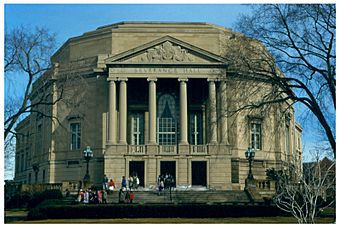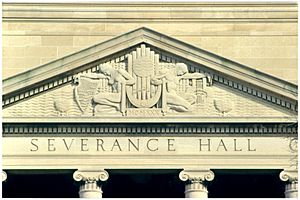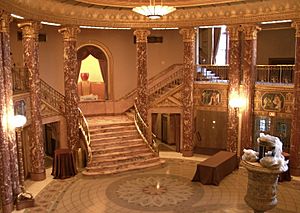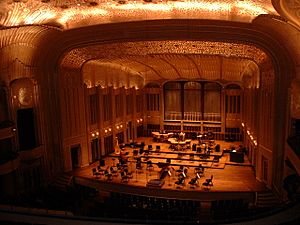Severance Hall facts for kids
 |
|
| Address | 11001 Euclid Avenue Cleveland, Ohio United States |
|---|---|
| Coordinates | 41°30′23″N 81°36′34″W / 41.50639°N 81.60944°W |
| Owner | Cleveland Orchestra |
| Operator | Cleveland Orchestra |
| Capacity | Concert hall: 2,000 Reinberger Chamber Hall: 402 |
| Construction | |
| Opened | February 5, 1931 |
| Reopened | 2000 |
| Architect | Walker and Weeks |
Severance Hall is a famous concert hall in Cleveland, Ohio. It opened in 1931. The hall is named after its generous supporters, John L. Severance and his wife, Elisabeth Huntingdon DeWitt Severance. It is the main home for The Cleveland Orchestra. Today, Severance Hall is listed on the National Register of Historic Places. This means it is an important historical site.
Contents
History of Severance Hall
The Cleveland Orchestra first played in other buildings. They used Grays Armory and later the Masonic Auditorium. But these places hosted many different events. Sometimes, the Orchestra had to find another place to play. For example, they once had to move because of a poultry (chicken) show! The Orchestra soon realized they needed their own special concert hall. This would help with performances, practice, and radio shows.
Adella Prentiss Hughes, who started the Orchestra, and music director Nikolai Sokoloff encouraged the idea. Western Reserve University (now Case Western Reserve University) offered land for just $1.00 a year. Money for the building also came from the public and wealthy people. At a big concert celebrating the Orchestra's tenth birthday, John L. Severance and his wife, Elisabeth, promised $1 million. John Severance was the president of the Musical Arts Association. Another supporter, Dudley Blossom, and his wife gave $750,000 the next day.
Elisabeth Severance passed away in 1929. But John Severance wanted the hall finished as a tribute to her. Even with the Wall Street Crash of 1929 (a big economic problem) in 1929, building began on November 14, 1929. Mr. Severance ended up giving more than $2.6 million. The Cleveland company Walker & Weeks designed the hall. They also designed the Federal Reserve Bank of Cleveland and the Cleveland Public Library. Severance Hall opened on February 5, 1931. A special concert was broadcast live on the radio to celebrate.
Severance Hall is the home of The Cleveland Orchestra. It is also used for graduation ceremonies by Case Western Reserve University. People can also rent it for concerts, weddings, and other events. On the ground floor, there is a smaller room called Reinberger Chamber Hall. It seats 402 people and is used for smaller shows and talks before concerts.
Building Design and Style
The Cleveland company Walker & Weeks designed Severance Hall. It is located where Euclid Avenue and East Boulevard meet. The main entrance has a grand lobby with a domed ceiling. This area is called a rotunda. The main concert hall and other rooms spread out from here. The outside of the building looks like the nearby Cleveland Museum of Art. It has a classical front with columns. It also features an Art Deco design by New York artist Henry Hering.
The inside of Severance Hall has many different styles. These include Art Deco and parts of Egyptian Revival. The Grand Foyer has marble columns. It is decorated with patterns of papyrus and lotus flowers. These patterns are seen in many places. The main concert hall has a shiny silver ceiling. Its designs are based on old English lace from the 1700s.
Sound Quality (Acoustics)
Soon after Severance Hall opened, people noticed some sound problems. This was because of velvet curtains in the audience boxes. There was also thick carpet and a large space above the stage that absorbed sound. The removable shells used for the Orchestra did not reflect sound well. Also, the large 6,025-pipe Ernest M. Skinner organ was outside the main hall. This made it hard to fix the "dry" sound inside.
In 1958, music director George Szell asked for changes to the sound. To make the hall sound better, they removed the velvet curtains. They also used less carpet. On the stage, a permanent sound shell was built. People called it "The Szell Shell." It had thick wooden walls shaped in curves. These walls were filled with sand to make them less absorbent and more reflective of sound. This made the hall sound much more lively. It really helped the Orchestra's sound under Szell.
However, the new Modern stage looked very different from the elegant Art Deco style of the hall. Also, the new shell blocked the organ pipes. This meant the organ could only be heard using microphones and speakers.
Updates and Changes
In 1970, the tiled drive-through entrance of Severance Hall was closed. This was because fewer people used taxis and chauffeured cars. The space was then turned into a dining area. Later, a hallway on the ground floor became a dressing room for female orchestra members. Before this, a harpist named Alice Chalifoux had to use her instrument case to change clothes!
From 1998 to 2000, Severance Hall had a big renovation. It cost $36 million and was led by architect David M. Schwarz. The updated building reopened in January 2000. It even won an award for historical preservation. The biggest change was replacing "The Szell Shell." The new shell had great sound like the old one. But it also looked much better and matched the hall's Art Deco style. The new stage also had a place for the Orchestra's newly fixed Ernest M. Skinner organ. The project also added a new lobby at street level, a new restaurant, and more offices for the Orchestra's staff.
See also
 In Spanish: Severance Hall para niños
In Spanish: Severance Hall para niños




